I recently visited the Field Museum in Chicago, Illinois. As I wandered through the exhibits, I came upon a display showcasing the bones of Lucy, a famous hominin skeleton from East Africa. Her bones are representative of a genus of extinct apes called the australopithecines. Most conventional scientists believe that these creatures were ancestral to the first humans. But how do the australopithecines fit into a creationist view of history? Was this three and a half foot tall ape really my ancestor?
The views expressed in this article reflect those of the author mentioned, and not necessarily those of New Creation.
The Discovery of The First Australopithecine
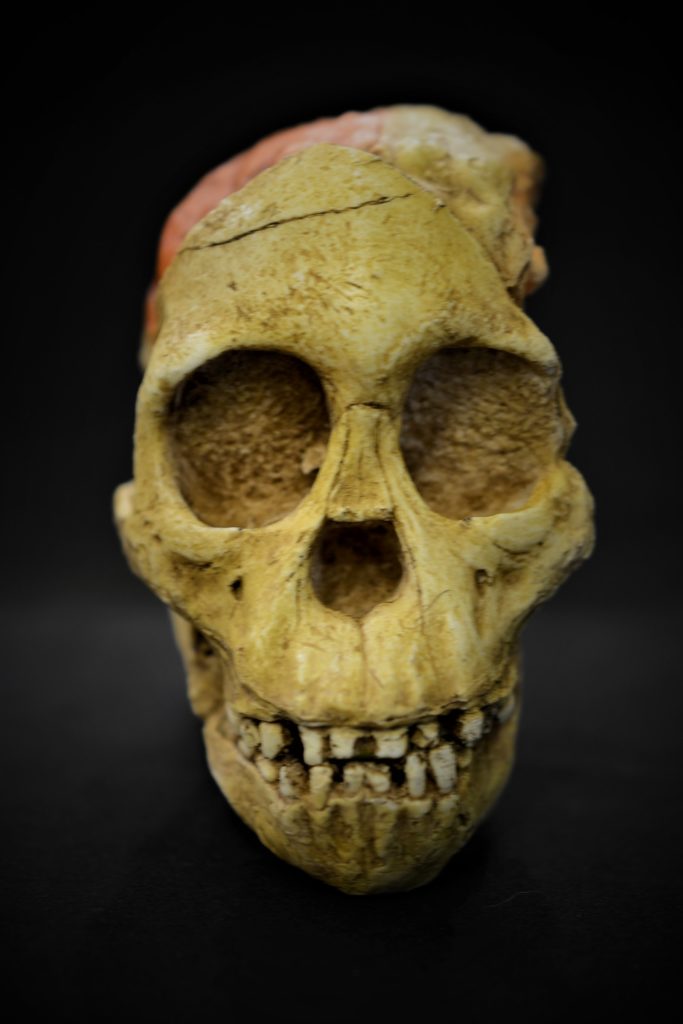
In 1924 a small fossil skull came to light in a quarry near Taung, South Africa. A professor of geology at the University of the Witwatersrand in Johannesburg, South Africa obtained this fossil along with several others. He shipped the bones to his colleague, Raymond Dart, an eccentric anatomist who had only recently moved to South Africa from London.
The crates of fossils arrived at Dart’s home on a Saturday late in 1924. Unaware of the timing of the delivery, he had planned to host a wedding reception at his home that afternoon. The shipment came while he was preparing for the reception. Unable to contain his excitement, Dart rushed outside to open the boxes. Still partially undressed, he pried the lids off of the wooden crates. Upon opening the second box he immediately recognized a tiny fossilized brain cast. The bridegroom was only able to pull Dart away from the precious fossil after it had been safely locked away.
Over three months Dart tirelessly prepared the fossil using his wife’s knitting needles. Just before Christmas, he freed the skull from the rock which encased it. The fossil was that of a juvenile ape. It preserved a natural cast of the brain as well as the front of the cranium and mandible. The skull was nicknamed the “Taung Child” after the site at which it had been discovered.
Raymond Dart’s Interpretation
In 1925 Dart published his analysis of the fossil in the journal Nature. Although the Taung Child was similar to chimpanzees and gorillas in many ways, Dart noted that certain attributes of the forehead, teeth, and brain shape seemed human-like. As a result, he believed it to be an “extinct link between man and his simian ancestor.” Dart designated this fossil to a new species, Australopithecus africanus.
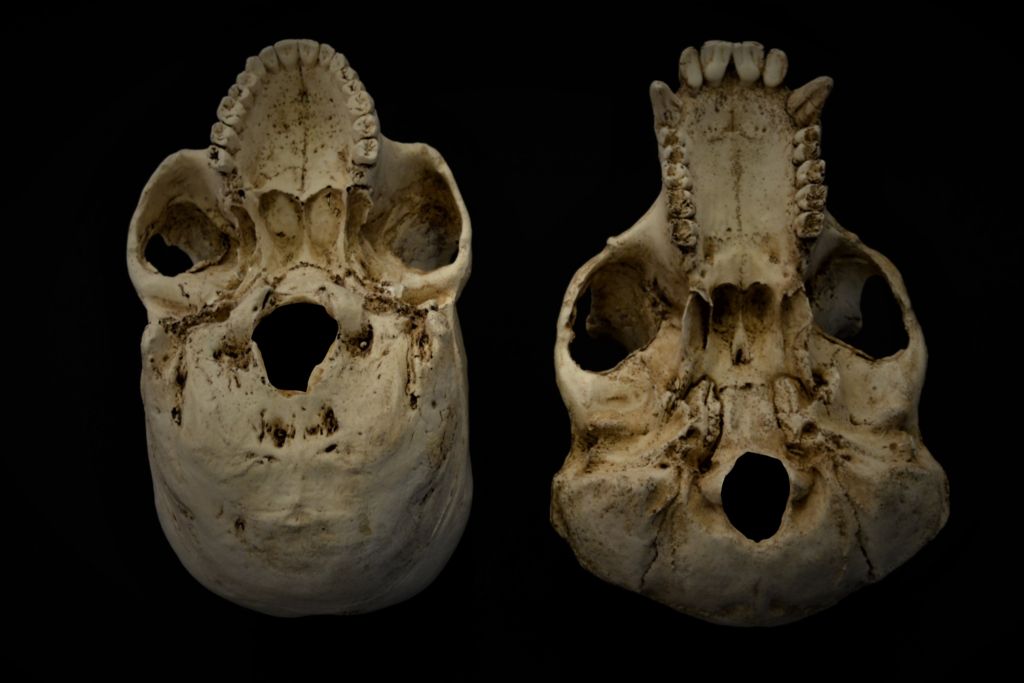
Dart was particularly interested in the foramen magnum of the Taung Child. The Foramen Magnum (Latin for big hole) is an opening in the bottom of the skull through which the brain stem connects to the spinal column. Humans have a foramen magnum which is centrally placed on the bottom of the skull and has very little angling towards the rear. This feature allows our head to be positioned immediately atop a vertical spinal column. Chimpanzees, however, have a heavily angled foramen magnum close to the rear of the skull. Since Chimpanzees normally walk on all fours, their spinal column is held in a roughly diagonal position and their head sticks out in front of their body. We now know that we cannot use this feature alone to diagnose bipedalism, but it is part of a suite of characters seen in bipeds.
Dart realized that the Taung Child had a foramen magnum which was close to the position seen in humans. He suggested that this anatomical feature belied an underlying functional similarity to humans, stating, “It means that a greater reliance was being placed by this group upon the feet as organs of progression”. Initially, others in the scientific community ridiculed Dart’s ideas. Critics pointed out that juvenile apes tend to look more human-like than adults, even concerning the position of the foramen magnum. The following discoveries of more Australopithecus skulls refuted Dart’s critics by demonstrating that even adults had a centrally placed foramen magnum.

More Australopithecus Discoveries
Since the discovery of the Taung Child, many more Australopithecus fossils have come to light. Many of these findings come from the Sterkfontein Cave System of South Africa. In 1947, Robert Broom uncovered a partial skeleton called Sts 14. This fossil preserved the backbones, hip bones, and thigh bone of a small female. In 1994 Dr. Ronald Clarke found StW 573, a nearly complete skeleton which he nicknamed “Little Foot”.
Australopithecine Anatomy
Skull & Teeth
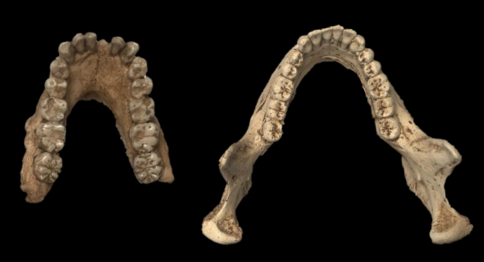
Australopithecines had many unique cranial and dental features. They had a cranial capacity of about 470 cubic centimeters on average. This made their brains about a third larger than the average chimpanzee’s. Their face was quite broad because of their projecting cheekbones. Their jaw took on a “U” shape quite different from the nice parabola seen in humans. Behind their incisors, (the four teeth in the front of the jaw), australopithecines had a shelf that extended backward. They also had large molar teeth suited for eating vegetation.
Limb Bones
Limb bones are very informative when reconstructing extinct animals. As a result of comparing fossils to living organisms with similar limb proportions, we can theorize how they might have walked. Chimpanzees have very long, muscular arms and short legs. This functional arrangement allows them to be proficient at climbing and hanging from branches. It is also suited for knuckle-walking along the ground because it raises the front of their torso giving them a better line of sight. Humans, on the other hand, have long legs and short arms because our legs serve as our main mechanism of propulsion. The Little Foot skeleton (StW 573) preserves complete limb bones, allowing us to compare it to chimpanzees and humans. Like humans, Little Foot’s leg was longer than its arm. This similarity is likewise consistent with the idea that the australopithecines were suited for walking upright.
Foot Bones
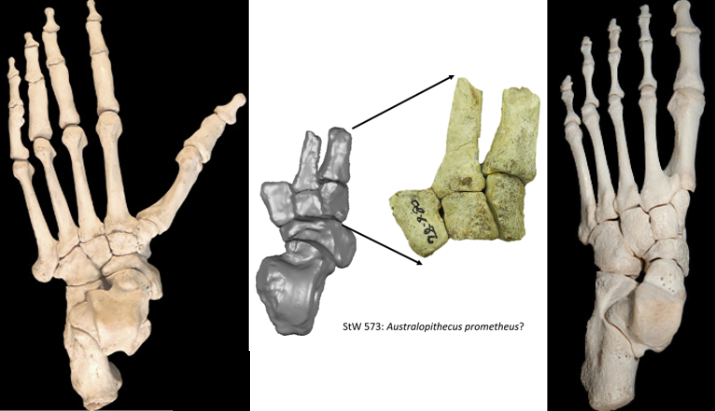
The foot is another diagnostic part of the body. Apes like chimpanzees and gorillas have a hallux (big toe) that sticks out to the side. This feature allows them to grasp branches with their feet. Humans have a hallux which is in line with the rest of the toes, this makes grasping anything with your feet basically impossible. Little Foot’s bones show that australopithecines did not have the divergent hallux of chimpanzees and gorillas. Instead, their hallux was convergent like those of humans. Studies suggest that their big toe may have had slightly more mobility than that of a human, but could not function as a grasping mechanism while climbing.
Hip Bones
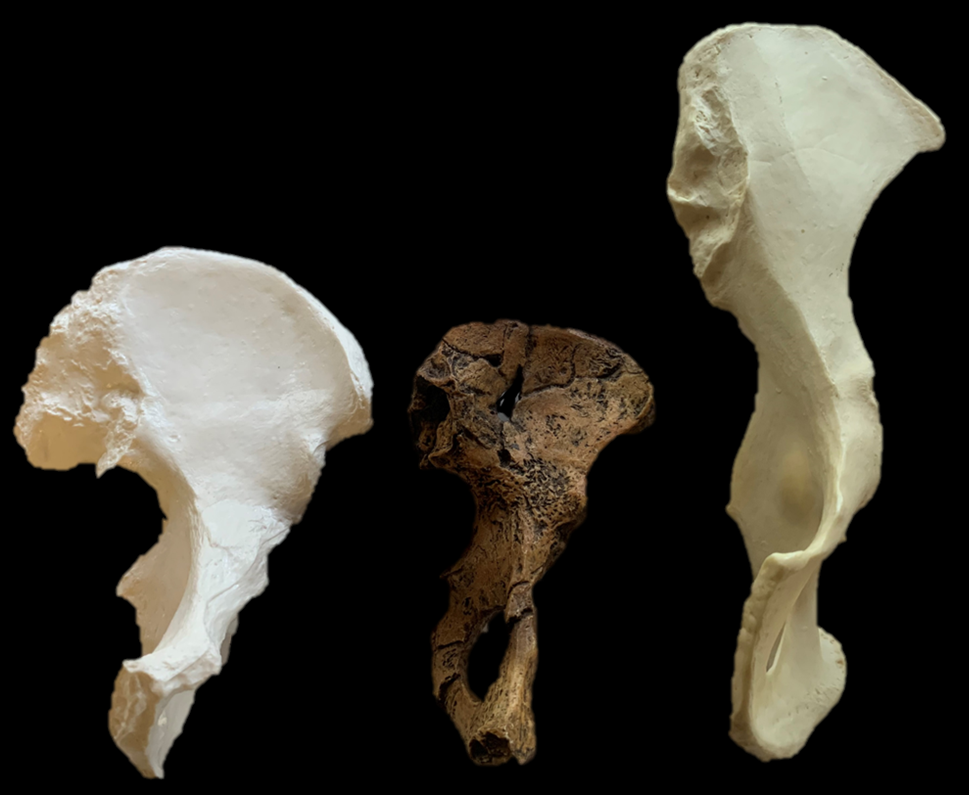
The hip bone or os coxae can tell us about how a creature moves. Chimpanzees have a flattened and elongated ilium which does not form the bowl-shaped pelvis seen in humans. Australopithecine pelves had more human-like proportions. Their pelvis formed a bowl shape similar to ours, but wider. This resemblance implies that they distributed their weight in a similar manner to humans while moving.
Inner Ear
CT scans of australopithecine skulls have allowed us to look at their inner ear canals. These structures within the skull play a role in balance. The inner ear canals of Little Foot (StW 573) share features with both chimpanzees and humans. Studies suggest that the functional result of these similarities would have resulted in the ability to sustain balance in a variety of conditions. The shape of the australopithecine’s inner ear would not have prevented them from being bipedal, although they may not have been as agile as humans.
Upper Limb
Although the Australopithecines’ lower limb shows clear indications of bipedalism, their upper limb shares features with tree climbing apes. CT scans of the bones of Lucy, (another famous Australopithecus skeleton), show that the shaft of her upper arm bone was stronger than that of a human. The bones of her fingers have a distinctive curvature, which would have helped her grasp branches while climbing.
The Hyoid Bone
We do not see many important human features in the australopithecines. One particular trait is the ability to talk, which relies heavily on the hyoid bone, which anchors the muscles of our tongue. In chimpanzees, however, the hyoid bone has a bulge, not seen in humans, which attaches to air sacs in the larynx. These sacs allow chimpanzees to inhale extra oxygen and may help them vocalize in ways that humans cannot. The only known Australopithecus hyoid bone comes from a juvenile skeleton found in Ethiopia. This bone shows an extension for laryngeal air sacs, indicating that this species vocalized similarly to chimpanzees.
Dissenting Opinions
Many creationists disagree with the characterization of the australopithecines as bipedal. In their attempt to uphold the uniqueness of humans, they overlook the possibility that God created bipedal apes unrelated to humans. Instead, their view of the australopithecines stems broadly from the works of Solly Zuckerman and Charles Oxnard. Zuckerman and Oxnard were British anatomists who researched primate morphology and behavior. They were by no means creationists, but they did not believe that the australopithecines were directly ancestral to humans. Their studies of the australopithecines tended to overemphasize features associated with tree climbing, and in effect downplay the importance of features related to habitual bipedalism. Although they conceded that the australopithecines may have walked upright occasionally, they saw them primarily as tree climbers and knuckle walkers.
In contrast, the bones seems to point to the opposite conclusion; the australopithecines were habitual bipeds who sometimes climbed trees. One feature which supports this view is the presence of lumbar lordosis, a curvature of the lower spine. Modern humans have a lumbar curve which acts like a spring to cushion our steps. This feature is developmental; it forms in babies as they learn to walk upright. Scientific studies of monkeys show that they, too, will develop a lumbar curve if they are trained to walk on their hind limbs. Measurements of australopithecine bones show that they had lumbar lordosis well within the range of modern humans. Significantly, this indicates that australopithecines were habitually walking on their hind limbs.
Reconstructing The Australopithecines
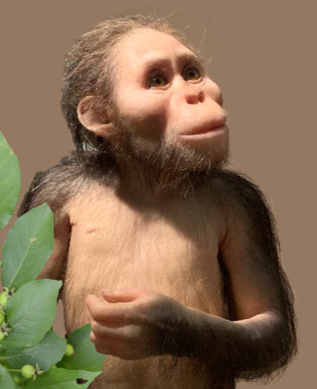
The australopithecines once lived throughout much of Eastern and Southern Africa. They probably inhabited wooded grasslands and similar environments. Much of their time would have been spent walking bipedally through the grasslands to find food. In fact, the ability to walk on their hind legs probably gave them several advantages. First, their upright posture would have helped them spot predators from further away. It also would have given them the ability to gather and carry food with them. Studies of their teeth indicate that they would have eaten grasses, roots, fruits, and small animals. Their ability to climb probably helped them to collect high-nutrition food like fruit and to shelter in the trees for safety at night. Thermal studies evaluating the loss of body heat suggest that the Australopithecines would have needed a fur coat to counteract nightly drops in temperature.
Were the Australopithecines our Ancestors?
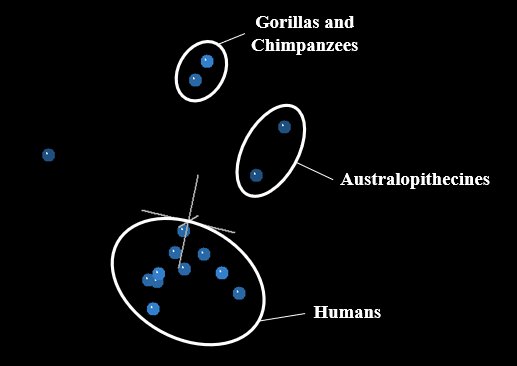
Statistical studies of australopithecines have shown that they are distinct from both humans and chimpanzees. We can visualize this distinction in a Multidimensional Scaling Graph like that shown. From graphs like these, we can see that humans form their own distinctive cluster. Australopithecines fall into their own cluster. The gap between the australopithecines and humans indicates that these groups are separate, or discontinuous. If the australopithecines were our ancestors, we should not be able to detect such strong separation between them and the earliest humans. Overall, the australopithecines are too different from the earliest humans to have been directly ancestral to them.
How Should Creationists Understand the Australopithecines?
The Bible teaches that God specially created humans on the sixth day of creation. Adam was made separately from the rest of creation because God chose him to have dominion over it. The Australopithecines are unrelated to humans. Either they belong to their own created kind, or they are part of a larger ape kind. Following the Flood, these creatures walked to Africa which they inhabited for some time. Their extinction may be correlated to the first appearance of humans in the region. These bipedal apes showcase the diversity of God’s creation. They also show that it is not our ability to walk upright which makes humans special. Our value comes from being endowed with the Image of God.
Footnotes
- Barrett et al. (2016) “Bipedality and hair loss in human evolution revisited: The impact of altitude and activity scheduling” Journal of human Evolution 94 Pg. 72-82. https://doi.org/10.1016/j.jhevol.2016.02.006
- Beaudet et al. (2019) “The bony labyrinth of StW 573 (“Little Foot”): Implications for early hominin evolution and paleobiology” Journal of Human Evolution 127 Pg. 67-80. https://doi.org/10.1016/j.jhevol.2018.12.002
- Been et al. (2012) “Lumbar lordosis of extinct hominins” American Journal of Physical Anthropology. https://doi.org/10.1002/ajpa.21633
- Brain, C.K. (2003). “A Century of Nature: Twenty-One Discoveries that Changed Science and the World” Pg. 3-9.
- Cartmill, Matt (2004) “Charles Oxnard: an appreciation” Cambridge University Press. DOI:10.1017/CBO9780511542336.002
- Dart, Raymond (1925) “Australopithecus africanus: The Man-Ape of South Africa” Nature. https://www.nature.com/articles/115195a0.pdf
- Murdock, Matthew (2006) “These apes were made for walking: the pelves of Australopithecus afarensis and Australopithecus africanus” Journal of Creation
- Ruff et al. (2016) “Limb Bone Structural Proportions and Locomotor Behaviour in A.l. 288-1 (“Lucy”).” PLoS One. doi:10.1371/journal.pone.0166095
- Sinclair, Wood (2021) “Revising Hominin Baraminology with Medoid Partitioning and Fuzzy Analysis” Answers Research Journal 14, pg. 451-462
- Wynn et al. (2013) “Diet of Australopithecus afarensis from the Pliocene Hadar Formation, Ethiopia” PNAS. https://doi.org/10.1073/pnas.1222559110

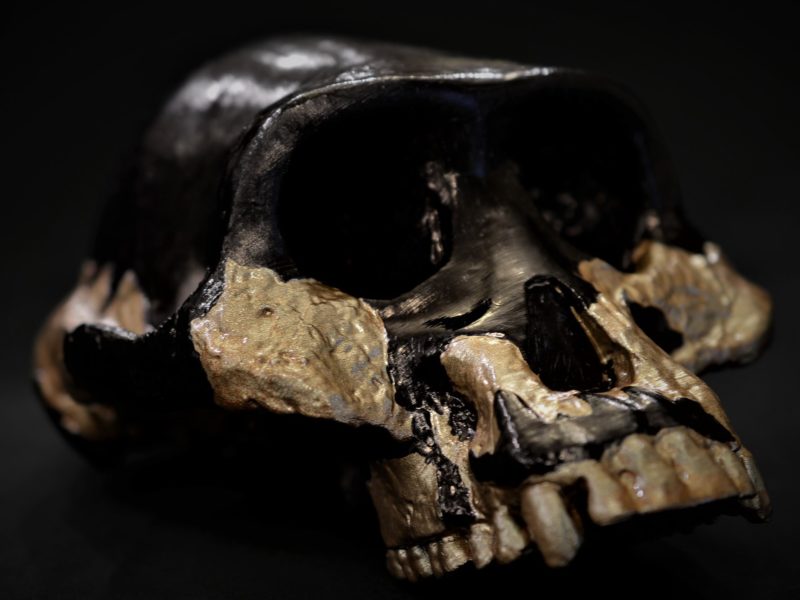
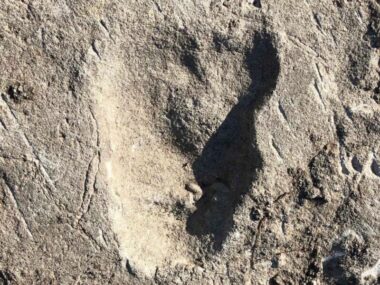
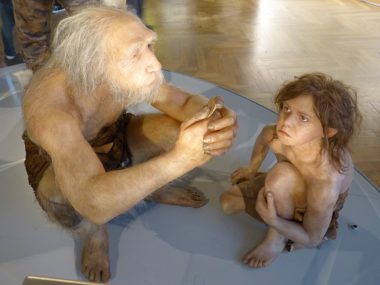

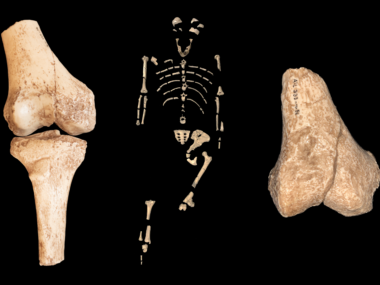






Good article brother.
You know, since you’re geology experts, I was wondering if, if you have the time and God willing, you could refute a video from a youtuber called Paleo 101, who uploaded a video called “Debunking Timothy Clarey institute for Creation”.
Upload videos about the “geological eras” evolution as if they were super real science when it is your subjective interpretation of reality.
Greetings .
Thanks! We have several articles addressing whether or not geological layers reflect long periods of time on the blog. I’d suggest checking out Dr. Coulson’s article on the Coconino Sandstone which discusses the evidence which suggests that this layer did not form over a long period of time in an eolian enviroment, but during the Flood.
https://newcreation.blog/was-the-coconino-sandstone-really-formed-in-a-desert/